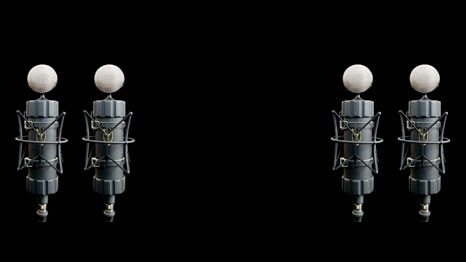Beyond the Faulkner phased array - the 'Audio Masterclass Quad'

One of the problems in recording an orchestra is that the main stereo pair of microphones must be placed closer than the natural listening distance because of their over-sensitivity to reverberation in the auditorium compared to the human ear/brain system.
This favors the front rows of instruments at the expense of the rear, and the result is an unnatural overall sound. This is usually cured by introducing additional microphones, but this inevitably also introduces more 'fog' into the sound and less clarity.
So if a stereo technique could be developed that would allow the main stereo pair of microphones to have a narrower angle of coverage, then they could be placed further away, closer to the natural listening position, for a natural perspective.
One solution to this has been employed by the respected British recording engineer Tony Faulkner, in the form of the 'Faulkner phased array', as it is commonly known.
In this, two figure-of-eight microphones are placed parallel to each other spaced apart by 200 mm.
The figure-of-eight microphone indeed has the tightest directional pattern of any of microphone type (other than interference tube or parabolic reflector mics, where sound quality suffers significantly). The drawback is that there is an equal pickup to the rear, but if the acoustics of the auditorium are good then this should not be a problem.
I have tried the Faulkner phased array myself, and although I don't seem to get results quite as good as the originator, they are certainly interesting and the technique is worth having in one's repertoire of mic techniques.
However, I would ideally like to place the mics even further back, which would require a yet tighter directivity pattern.
To do this I have borrowed a technique from radio astronomy. A radio telescope is like a large satellite dish antenna, picking up radio signals from the universe rather than satellite TV. Bigger is better as the telescope can be more tightly focused and resolve finer detail in the sky.
However, for the ultimate precision in radio astronomy, data from two telescopes can be synchronized, effectively making a telescope of size equal to the distance between the two individual telescopes.
You can do this with microphones too...
Here, I recommend two figure-of-eight microphones per channel all facing in parallel towards the orchestra.
The two mics for the left channel would both be panned hard left, and the two right channel mics panned hard right.
The spacing of the microphones would be a matter for experimentation in the venue. The spacing of the mics for each channel should be judged according to the directivity required. A wider spacing would give tighter directivity. The spacing of the left and right pairs should be judged according to the stereo image required. All the mics should be set at the same gain.
At this point more data is needed to prove the value of this system. If you have the opportunity to try it out, please let us know how you get on. And send us your recording!
Perhaps this system will come to be known as the 'Audio Masterclass Quad'?
By the way, the mic illustrated is the Violet Flamingo. Now if you can afford four of these...






























